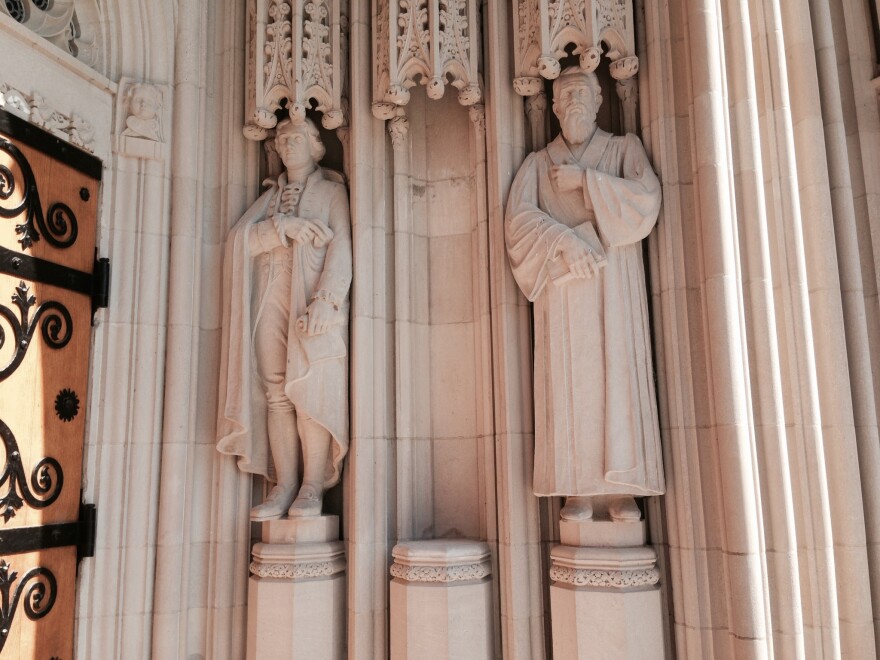Editor's Note: In December, Duke University announced it will leave an empty space where it removed a statue of Confederate General Robert E. Lee. That's so it can spend another year studying a proper replacement. President Vincent Price approved the yearlong study period recommended by a campus historical commission. The commission was convened in September after the statue's removal. Lee was among 10 figures depicted at Duke Chapel in or near its entryway.
Duke University quickly and quietly removed a controversial statue from its most iconic building over the weekend. Early Saturday morning, a crew removed a memorial to General Robert E. Lee from its place on the outside wall of Duke Chapel. This comes at a time when many states are trying to reconcile the future of their Confederate monuments and history.
The famous Duke University Chapel is known around the world. There are always visitors and students taking pictures of the gothic structure. So, in many ways this past Saturday was a normal Saturday, as Duke Chapel’s Organ Scholar warmed up to play at three weddings.
But just outside the doors of the chapel, change had come. By early morning, a statue of General Lee was no longer there and there was a visible hole where it once stood.
"The statue was brought down very sensitively and delicately with no further damage beyond what was done by the vandalism Wednesday night," said Michael Schoenfeld, Duke's vice president for public affairs and government relations.
Schoenfeld said when vandals chipped off part of the statue’s nose and eyes earlier last week, outcry over a Civil War remnant became an issue of safety and security in a house of worship.
“That is probably, possibly one of the most visible and important locations on the Duke campus, in front of our most visible and iconic building," said Schoenfeld. "As a community, we need to deliberate what kinds of messages we send as a university by the people that we honor there.”
There were 10 statues greeting chapel visitors. Among them, a statue of Methodist leader John Wesley is prominently over the front door.
"Those statues have been there since the chapel opened in 1932. So in some respects, to some people they have been hiding in plain sight," said Schoenfeld.
But these Confederate monuments, many see as relics to the Civil War and to a time when blacks were enslaved, are now in the spotlight. Last week, the mayor of Baltimore also felt the need to “quickly and quietly” remove four such statues, which included one of Robert E. Lee. Catherine Pugh said the statues had become a security threat, including the deadly fallout in Charlottesville, Virginia over a Robert E. Lee statue there.

Here in Durham, a group of demonstrators moved quickly, but not quietly, in taking down a Confederate statue of a nameless soldier outside the old county courthouse downtown last week, too. On Friday, they celebrated its removal, again, chanting "We Tore it Down!"
The President of Duke University, Vincent Price, said in a statement over the weekend, the removal of the Lee statue creates an opportunity for the Duke community to learn and heal.
Luke Powery, dean of Duke Chapel, said he sees the hole where the Lee statue once stood, between likenesses of Thomas Jefferson and Poet Sidney Lanier, as a way to welcome deep conversations.
“An opening recognizes the truth, acknowledges the truth, but also it’s an opening perhaps for working towards healing and something better and a mutual understanding between each other," said Powery, standing outside the chapel Saturday morning.
Duke University is creating a commission to advise on how to memorialize individuals on the Duke Campus.

One year ago, Duke’s Main Quad was officially named after Julian Abele, the African-American architect from Philadelphia who designed much of the campus, including Duke Chapel.
It’s hard to confirm if Abele ever got the chance to actually see what he had helped build in Durham, North Carolina, in the Jim Crow south. Maybe now there’s a space for him at the front door.










